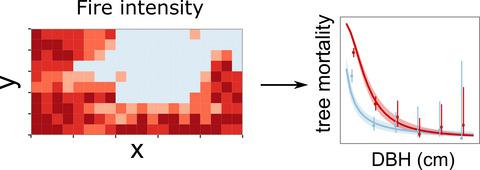Our official English website, www.x-mol.net, welcomes your feedback! (Note: you will need to create a separate account there.)
Disentangling fire intensity and species’ susceptibility to fire in a species‐rich seasonal tropical forest
Journal of Ecology ( IF 5.5 ) Pub Date : 2020-01-06 , DOI: 10.1111/1365-2745.13343 Raphaël Trouvé 1 , Sarayudh Bunyavejchewin 2 , Patrick J. Baker 1
中文翻译:

区分物种丰富的季节性热带森林中的火势和物种对火的敏感性
更新日期:2020-01-06
Journal of Ecology ( IF 5.5 ) Pub Date : 2020-01-06 , DOI: 10.1111/1365-2745.13343 Raphaël Trouvé 1 , Sarayudh Bunyavejchewin 2 , Patrick J. Baker 1
Affiliation

|
- Increasing temperatures and human activity are likely to reduce fire return intervals in the seasonal tropics. Anticipating how more frequent fires may alter forest community structure and composition requires understanding how fire intensity and species‐specific responses to fires interact to drive fire‐induced mortality for large numbers of species. We developed an analytical framework to estimate unobserved fire intensities and species‐ and size‐specific susceptibility to fire using observed mortality data.
- We used census data from a 50‐ha forest dynamics plot in western Thailand to better understand species and community responses to a fire that burned ∼ 60% of the plot in 2005. Trees species, size and status (live, dead) were censused just before the fire (2004) and again 5 years later (2009). We jointly estimated a map of relative fire intensity and species‐specific size‐dependent background and fire‐induced mortality. We then calculated the time required for individuals of each species to reach a fire‐safe size threshold (the age at which the fire‐induced mortality probability was <50%). To better understand community‐level responses to fire, we compared results among different species groups (canopy status, forest‐type association).
- Our model‐derived map of fire intensity closely matched the field survey taken in the days after the fire. On average, individuals growing at the 95th percentile growth rate for most species groups required ∼ 5 years to reach their species’ fire‐safe size threshold, while individuals growing at the median growth rate required ∼ 17 years (assuming growth <1 cm diameter at breast height was similar to growth >1 cm). However, understorey species associated with the seasonal evergreen forest took 1.8 times longer than average to reach their fire‐safe size threshold, with one species requiring up to 190 years.
- Synthesis. Our approach provided insights into spatial patterning of fire intensity in a seasonal tropical forest and species‐ and size‐specific susceptibility to fire‐induced mortality. Our results suggest increasing fire frequency will have the greatest impact on slow‐growing understorey species of the evergreen forest. In addition, our model accurately predicts the growing dominance of a fast‐growing understorey species, Croton roxburghii; Euphorbiaceae, common to evergreen and deciduous forests that can reach its fire‐safe size threshold in 1.3 years.
中文翻译:

区分物种丰富的季节性热带森林中的火势和物种对火的敏感性
- 升高的温度和人类活动可能会减少季节性热带地区的回火间隔。预测更频繁的火灾将如何改变森林群落的结构和组成,需要了解火灾强度和物种对火灾的反应如何相互作用,以驱动大量物种的火灾死亡。我们开发了一个分析框架,使用观察到的死亡率数据来估计未观察到的火势以及特定物种和大小的火灾敏感性。
- 我们使用了来自泰国西部50公顷森林动态图的人口普查数据,以更好地了解物种和社区对2005年烧毁约60%土地的大火的反应。仅对树木的种类,大小和状况(有生命,无生命)进行了人口普查。在大火之前(2004年)和5年后(2009年)再次发生。我们共同估算了相对火灾强度和特定物种的大小相关背景以及火灾致死率的地图。然后,我们计算了每个物种的个体达到防火大小阈值(火灾致死概率小于50%的年龄)所需的时间。为了更好地了解社区对火的反应,我们比较了不同物种组(林冠状态,森林类型关联)的结果。
- 我们根据模型得出的火势图与火灾后几天进行的现场调查非常吻合。平均而言,大多数物种组以95%的增长率生长的个体需要约5年才能达到其物种的防火尺寸阈值,而以中值增长率生长的个体则需要约17年(假设生长直径小于1厘米)。乳房高度类似于> 1 cm的增长)。但是,与季节性常绿森林相关的林下物种达到其防火尺寸阈值所需时间比平均时间长1.8倍,其中一种物种需要长达190年的时间。
- 合成。我们的方法提供了洞察力,可以了解季节性热带森林中火势的空间格局,以及因物种和大小而异的火灾致死率。我们的结果表明,不断增加的火灾频率将对常绿森林的生长缓慢的林下物种产生最大的影响。此外,我们的模型可以准确地预测快速生长的底层植物巴豆(Croton roxburghii)的优势。大戟科,常绿和落叶林常见,可以在1.3年内达到其防火规格的阈值。


























 京公网安备 11010802027423号
京公网安备 11010802027423号